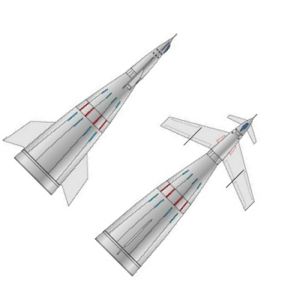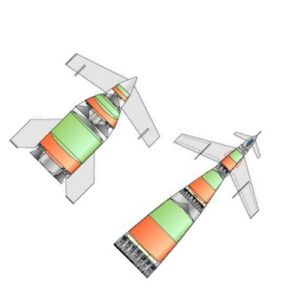
Home - Search - Browse - Alphabetic Index: 0- 1- 2- 3- 4- 5- 6- 7- 8- 9
A- B- C- D- E- F- G- H- I- J- K- L- M- N- O- P- Q- R- S- T- U- V- W- X- Y- Z
Von Braun 1952
 Von Braun 1952 Credit: © Mark Wade |
AKA: A12. Status: Study 1952. Payload: 25,000 kg (55,000 lb). Thrust: 119,300.00 kN (26,819,700 lbf). Gross mass: 6,400,000 kg (14,100,000 lb). Height: 97.00 m (318.00 ft). Diameter: 20.00 m (65.00 ft). Apogee: 1,730 km (1,070 mi).
For the drawings and paintings to illustrate the 1952 Colliers series and subsequent books, the 1948 version was found to be too dumpy and squat to inspire. Therefore, Von Braun, in collaboration with artist Rolf Klep, sketched a much more elegant tapered launch vehicle design. The still somewhat-squat official version became even more stretched and elegant looking in the artist's renderings. This can be contrasted with Von Braun's Redstone, then already in design, which used the uninspiring but efficient cylindrical body that would be the basis of his later Jupiter and Saturn rockets. One can only conclude that Von Braun went along with the artist's desires for a more glamorous-looking rocket ship.
The base diameter of the first stage remained the same, but those of the upper stages were drastically reduced. To make more room for engines in the base, the parachute package was changed from a centrally-located canister to a steel-mesh circular drag brake, stored along the outer fuselage. The engine concept was now changed from an annular nozzle to separate conventional bell-nozzle engines. Since the first stage diameter was the same, and the parachute canister that took up half its diameter was deleted, there was enough room in the first stage for 52 such engines. However there were real problems in using the 1948 calculations for the upper stages.
The second stage diameter was reduced from 20 m to 13.5 m. There was simply not enough base area for the total nozzle area indicated in Von Braun's original calculations. This could have been remedied if the chamber pressure was increased, as was clearly possible by 1952. However that should have resulted in a higher specific impulse, but the 1948 calculations were used 'as-is'. Klep's illustrations showed Redstone-type low-expansion ratio engines, inconsistent with the area ratio calculated in 1948 and needed for the high engine performance.
Similarly, the third stage diameter was reduced from 9.8 m to 5.8 m, with the same logical problem, since in the original calculation the nozzle occupied the entire base of the third stage.
LEO Payload: 25,000 kg (55,000 lb) to a 1,730 km orbit at 23.50 degrees.
Stage Data - Von Braun 1952
- Stage 1. 1 x Von Braun 1952-1. Gross Mass: 5,500,000 kg (12,100,000 lb). Empty Mass: 700,000 kg (1,540,000 lb). Thrust (vac): 141,286.300 kN (31,762,424 lbf). Isp: 257 sec. Burn time: 84 sec. Isp(sl): 217 sec. Diameter: 20.00 m (65.00 ft). Span: 37.00 m (121.00 ft). Length: 36.50 m (119.70 ft). Propellants: Nitric acid/Hydrazine. No Engines: 51. Status: Study 1952.
- Stage 2. 1 x Von Braun 1952-2. Gross Mass: 770,000 kg (1,690,000 lb). Empty Mass: 70,000 kg (154,000 lb). Thrust (vac): 16,271.100 kN (3,657,889 lbf). Isp: 298 sec. Burn time: 124 sec. Diameter: 13.50 m (44.20 ft). Span: 13.50 m (44.20 ft). Length: 20.70 m (67.90 ft). Propellants: Nitric acid/Hydrazine. No Engines: 34. Status: Study 1952.
- Stage 3. 1 x Von Braun 1952-3. Gross Mass: 105,000 kg (231,000 lb). Empty Mass: 22,000 kg (48,000 lb). Thrust (vac): 2,033.800 kN (457,216 lbf). Isp: 296 sec. Burn time: 105 sec. Diameter: 5.80 m (19.00 ft). Span: 48.00 m (157.00 ft). Length: 23.40 m (76.70 ft). Propellants: Nitric acid/Hydrazine. No Engines: 5. Status: Study 1952.
Family: orbital launch vehicle, Winged. People: von Braun. Country: Germany. Engines: Von Braun-3, Von Braun-1, Von Braun-2. Stages: Von Braun 1952-1, Von Braun 1952-2, Von Braun 1952-3. Bibliography: 218.
 | Cutaway of 1946 and Credit: © Mark Wade |
1952 February 11 - . LV Family: von Braun concept vehicle. Launch Vehicle: Von Braun 1952.
- Collier's Man Will Conquer Space Soon - . Nation: USA. Related Persons: Ley, von Braun. Collier's magazine published papers from First Symposium on Space Flight, under the title "Man Will Conquer Space Soon.". This was an important step in the popularization of the idea of manned space flight..
Back to top of page
Home - Search - Browse - Alphabetic Index: 0- 1- 2- 3- 4- 5- 6- 7- 8- 9
A- B- C- D- E- F- G- H- I- J- K- L- M- N- O- P- Q- R- S- T- U- V- W- X- Y- Z
© 1997-2019 Mark Wade - Contact
© / Conditions for Use